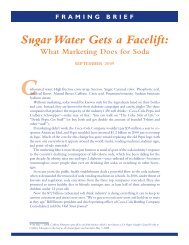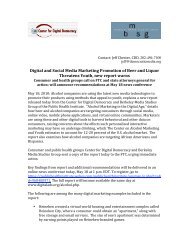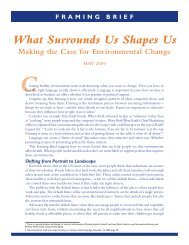"Interactive Food & Beverage Marketing" (PDF)
"Interactive Food & Beverage Marketing" (PDF)
"Interactive Food & Beverage Marketing" (PDF)
Create successful ePaper yourself
Turn your PDF publications into a flip-book with our unique Google optimized e-Paper software.
“Insert your brand in<br />
a conversation” across<br />
platforms, marketers<br />
were advised, using<br />
“touchpoints that can<br />
deliver both<br />
emotional and rational<br />
messages.”<br />
<strong>Interactive</strong> <strong>Food</strong> & <strong>Beverage</strong> Marketing | The New Digital Marketing Landscape<br />
influential youth, including Internet search sites; online coupons; text messaging from a<br />
brand to a cell phone or Personal Digital Assistant (PDA); as well as brand-sponsored,<br />
Web-based entertainment and Internet ads. “Insert your brand in a conversation” across<br />
platforms, marketers were advised, using “touchpoints that can deliver both emotional<br />
and rational messages.” 138<br />
Viral marketing is a key ingredient in the growing number of “360 degree” buzz<br />
campaigns, which frequently involve hidden messages and coded information to lure<br />
youth into an elaborate series of games and other activities across different media, thus<br />
generating buzz within the online youth subculture, all under the public radar. Several<br />
food and beverage companies have eagerly embraced this particular strategy. For example,<br />
• Cadbury Schweppes recently conducted an unconventional campaign for its soft<br />
drink, Dr. Pepper, built around “word-of-mouth and Internet buzz.” Tagging the<br />
effort “Hunt for More,” the company hid coins in high-traffic public locations in<br />
23 different cities. Customers could use codes in specially marked Dr. Pepper<br />
products to access a website, where they were given clues as to the location of<br />
the hidden treasure. Only one coin was placed in each city, and its redeemable<br />
value was between $10,000 and $1 million. 139<br />
• Frito-Lay launched a similar viral campaign to promote its popular Doritos brand<br />
among youth. Marketers placed a mysterious message on billboards that could<br />
only be deciphered by typing a text message into a cell phone, which then took<br />
people to the Doritos website. Once there, reported the website iMedia<br />
Connection, “young folks could read and post to blogs, socialize with others, win<br />
prizes and receive free IM buddy icons. An entire community was created using<br />
multiple content platforms.” 140<br />
• KFC used a high-pitched tone as a promotional “buzz” device for a recent “interactive<br />
advertising campaign.” The MosquitoTone was embedded in TV commercials<br />
to launch KFC’s new Boneless Variety Bucket. In its press release, the<br />
company explained that the popular cell phone ring tone “is too high-pitched for<br />
most adults to hear because most people begin to lose the ability to hear high<br />
frequency tones starting at age 20. This is a fact not lost on young Americans<br />
who seek the sound for clandestine ring tones that don’t turn the heads of nearby<br />
adults.” When inserted in the TV commercial, the secret sounds were<br />
designed to attract the attention of young viewers and “drive” them to a website,<br />
where they could enter a contest to identify exactly where the tones could<br />
be heard in the ad, in order to win $10 “KFC gift checks” redeemable for the<br />
new chicken meal at any KFC. The company’s chief marketing officer called the<br />
innovative buzz campaign “the 21 st Century dinner bell.” 141<br />
• Sprite created an alternate reality game “Lost Experience”—based on the highly<br />
popular ABC TV series, “Lost”—giving viewers “a way to further their pursuit of<br />
the show’s mystery while inadvertently engaging in a Sprite-branded website.”<br />
Marketers began by creating a “faux-commercial” that aired during an episode<br />
of the TV series, in order to “leak” the Web address—Sublymonal.com—to viewers.<br />
Once online, site visitors were invited to participate in a scavenger hunt with<br />
“DJ podcasts, videos and hidden memos.” Codes were also hidden in print ads<br />
in Entertainment Weekly and People magazines. As a result, more than<br />
500,000 codes were entered and Sprite’s Web traffic jumped 400 percent. 142<br />
37









